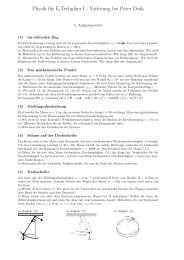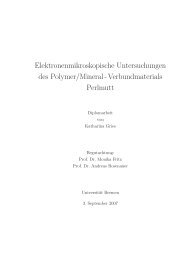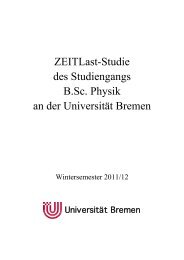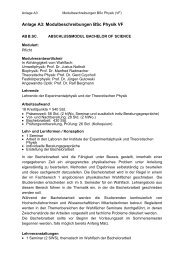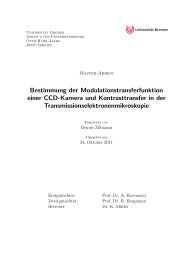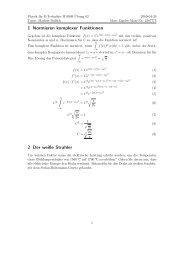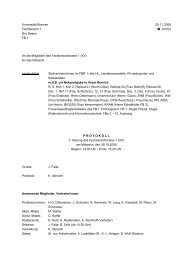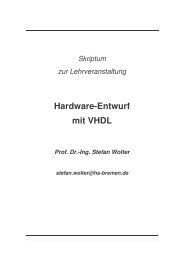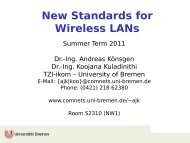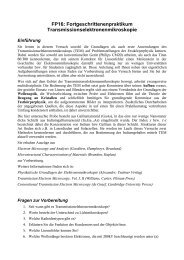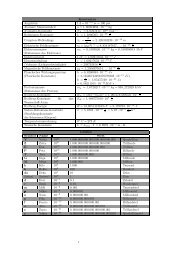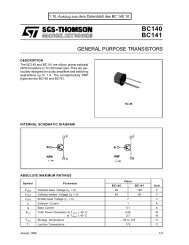Electro Optical Characterisation of Short Wavelength Semiconductor ...
Electro Optical Characterisation of Short Wavelength Semiconductor ...
Electro Optical Characterisation of Short Wavelength Semiconductor ...
Create successful ePaper yourself
Turn your PDF publications into a flip-book with our unique Google optimized e-Paper software.
Basic Concepts<br />
which by using 1.6 can be written as<br />
Adding up the band gap energy to both side leads to<br />
Efc + Efv > Ec + Ev. (1.11)<br />
Eg + Efc + Efv > Ec + Ev + Eg = hν > Eg. (1.12)<br />
Equation 1.12 represents the condition for optical gain. In the case <strong>of</strong> electrical pumping,<br />
this would imply that the externally applied electric field must result a separation <strong>of</strong> quasi<br />
Fermi energies, that exceeds the photon energy <strong>of</strong> the stimulated emission and the band<br />
gap energy <strong>of</strong> the semiconductor [37].<br />
Macroscopic Aspects<br />
<strong>Optical</strong> gain is necessary but not sufficient for lasing. A second aspect called optical feedback<br />
is also needed. The feedback enables the selectivity for the stimulated emission in terms<br />
<strong>of</strong> direction and wavelength and thus enables the laser oscillation. The optical feedback<br />
could be reached through two parallel semi-transparent mirrors brought on the both sides<br />
<strong>of</strong> the gain medium. This forms a Fabry-Pérot resonator.<br />
From the macroscopic point <strong>of</strong> view the matter is considered as a homogeneous medium<br />
described by the complex dielectric ε(ω) or by the complex index <strong>of</strong> refraction ñ(ω). Laws<br />
<strong>of</strong> reflection, transmission and absorption can be described from this point <strong>of</strong> view. In case<br />
<strong>of</strong> a Fabry-Pérot resonator the concentration is on reflection and transmission, as depicted<br />
in Fig. 1.7. Transmission coefficients t1 and t2 and reflection coefficients r1 and r2 are<br />
defined respectively.<br />
A plane wave propagating in the positive z direction could be written as Ee −Γz , whereas<br />
Γ is the complex propagation constant. A wave Ei meets the input mirror at z = 0<br />
perpendicular to the surface; a part will be reflected and a part transmitted. This happens<br />
every time the wave reaches any <strong>of</strong> both mirrors. For calculating the lasing conditions, it<br />
would be sufficient to only take the transmitted part on the output mirror at z = L into<br />
consideration. Summing up the transmitted fields delivers a geometric progression,<br />
Et = t1t2 Eie −ΓL + r1r2t1t2 Eie −3ΓL + · · ·<br />
= Ei<br />
<br />
t1t2e −ΓL<br />
1 − r1r2e −2ΓL<br />
<br />
· (1.13)<br />
Exactly at the laser threshold the cavity is invisible for the light. If the denominator <strong>of</strong><br />
Eq. 1.13 approaches zero, the condition <strong>of</strong> lasing oscillation is obtained because <strong>of</strong> a finite<br />
transmitted intensity Et remaining from an incident wave with vanishing intensity Ei;<br />
r1r2e −2ΓL ! = 1. (1.14)<br />
The complex propagation constant Γ includes the damping factor α and the phase φ = 2π<br />
λ<br />
<strong>of</strong> the wave, where λ is the wavelength,<br />
10


